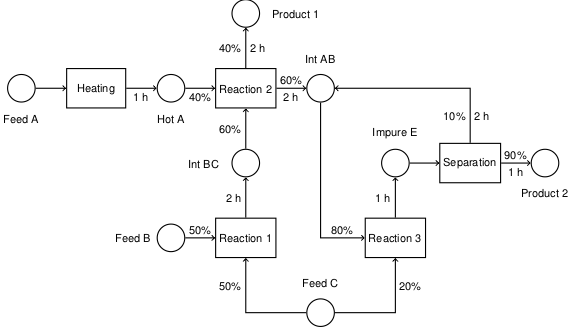4.1. Introduction to Disjunctive Programming#
4.1.1. Installations and imports#
%matplotlib inline
import matplotlib.pyplot as plt
import matplotlib as mpl
import pandas as pd
import shutil
import sys
import os.path
if not shutil.which("pyomo"):
!pip install -q pyomo
assert(shutil.which("pyomo"))
if not (shutil.which("cbc") or os.path.isfile("cbc")):
if "google.colab" in sys.modules:
!apt-get install -y -qq coinor-cbc
else:
try:
!conda install -c conda-forge coincbc
except:
pass
assert(shutil.which("cbc") or os.path.isfile("cbc"))
from pyomo.environ import *
from pyomo.gdp import *
import pandas as pd
4.1.2. Problem statement#
4.1.2.1. Component data#
# load data as dictionary of components
# component data consists of cost and composition
comp_data = {
"A": {"cost": 2.0, "Vit A": 0.5, "Vit B": 0.2},
"B": {"cost": 2.0, "Vit A": 0.4, "Vit B": 0.1},
"C": {"cost": 5.0, "Vit A": 0.3, "Vit B": 0.3},
}
# use pandas to create a nice display
pd.DataFrame.from_dict(comp_data, orient='index')
| cost | Vit A | Vit B | |
|---|---|---|---|
| A | 2.0 | 0.5 | 0.2 |
| B | 2.0 | 0.4 | 0.1 |
| C | 5.0 | 0.3 | 0.3 |
4.1.2.2. Product Composition Requirements#
Find the lowest cost blend
Vit A: less than 0.4
Vit B: greater than 0.2
Your code should be able to accept alternative specification for data and product requirements.
prod_req = {
"Vit A": {"lb": 0.0, "ub": 0.4},
"Vit B": {"lb": 0.2, "ub": 1.0},
}
pd.DataFrame.from_dict(prod_req, orient='index')
| lb | ub | |
|---|---|---|
| Vit A | 0.0 | 0.4 |
| Vit B | 0.2 | 1.0 |
4.1.2.3. Component Compatibility#
For this application, we consider an additional type of constraint specifying the incompatability of certain blends of components. For example, suppose we have a constraint:
A and B cannot be mixed together in the final product
The constraint is specified by creating a list of incompatabile pairs.
excl_pairs = [("A", "B")]
4.1.3. Version 0: Neglecting the compatibility requirments#
m = ConcreteModel()
# define sets that will be used to index decision variables and constraints
# remember to use initialize keyword
m.comp = Set(initialize=comp_data.keys())
m.req = Set(initialize=prod_req.keys())
# decision variables
m.x = Var(m.comp, domain=NonNegativeReals)
# objective function
m.cost = Objective(expr=sum(m.x[c]*comp_data[c]["cost"] for c in m.comp), sense=minimize)
# structural constraints
m.massfraction = Constraint(expr=sum(m.x[c] for c in m.comp)==1)
# composition constraints
m.lb = Constraint(m.req, rule=lambda m, r: sum(m.x[c]*comp_data[c][r] for c in m.comp) >= prod_req[r]["lb"])
m.ub = Constraint(m.req, rule=lambda m, r: sum(m.x[c]*comp_data[c][r] for c in m.comp) <= prod_req[r]["ub"])
solver = SolverFactory('cbc')
solver.solve(m)
for c in m.comp:
print(f"{c} = {m.x[c]()}")
A = 0.33333333
B = 0.33333333
C = 0.33333333
4.1.4. Version 1: Including compatibility requirements with Big-M#
The challenge of this problem are the disjunctive constraints associated with the component incompatability data. Here we associated a boolean variable for each pair, then use the boolean variable to determine which member of the pair to keep in the blend.
m = ConcreteModel()
# define sets that will be used to index decision variables and constraints
# remember to use initialize keyword
m.comp = Set(initialize=comp_data.keys())
m.req = Set(initialize=prod_req.keys())
# define a set to that includes the excluded pairs
m.pairs = Set(initialize=excl_pairs)
# decision variables
m.x = Var(m.comp, domain=NonNegativeReals)
# for each excluded pair, create a boolean variable. The value of the boolean
# variable will determine which member of the pair is allowed in the product
m.y = Var(m.pairs, domain=Boolean)
# objective function
m.cost = Objective(expr=sum(m.x[c]*comp_data[c]["cost"] for c in m.comp), sense=minimize)
# structural constraints
m.massfraction = Constraint(expr=sum(m.x[c] for c in m.comp)==1)
# composition constraints
m.lb = Constraint(m.req, rule=lambda m, r: sum(m.x[c]*comp_data[c][r] for c in m.comp) >= prod_req[r]["lb"])
m.ub = Constraint(m.req, rule=lambda m, r: sum(m.x[c]*comp_data[c][r] for c in m.comp) <= prod_req[r]["ub"])
# component incompatability constraints
M = 100
m.disj = ConstraintList()
for pair in m.pairs:
a, b = pair
m.disj.add(m.x[a] <= M*m.y[pair])
m.disj.add(m.x[b] <= M*(1-m.y[pair]))
solver = SolverFactory('cbc')
solver.solve(m)
for c in m.comp:
print(f"{c} = {m.x[c]()}")
A = 0.0
B = 0.5
C = 0.5
4.1.5. Version 2. Disjunctive Constraints#
m = ConcreteModel()
# define sets that will be used to index decision variables and constraints
# remember to use initialize keyword
m.comp = Set(initialize=comp_data.keys())
m.req = Set(initialize=prod_req.keys())
# define a set to that includes the excluded pairs
m.pairs = Set(initialize=excl_pairs)
# decision variables
m.x = Var(m.comp, domain=NonNegativeReals, bounds=(0, 1))
# objective function
m.cost = Objective(expr=sum(m.x[c]*comp_data[c]["cost"] for c in m.comp), sense=minimize)
# structural constraints
m.massfraction = Constraint(expr=sum(m.x[c] for c in m.comp)==1)
# composition constraints
m.lb = Constraint(m.req, rule=lambda m, r: sum(m.x[c]*comp_data[c][r] for c in m.comp) >= prod_req[r]["lb"])
m.ub = Constraint(m.req, rule=lambda m, r: sum(m.x[c]*comp_data[c][r] for c in m.comp) <= prod_req[r]["ub"])
# component incompatability constraints
m.disj = Disjunction(m.pairs, rule=lambda m, a, b: [m.x[a] == 0, m.x[b] == 0])
# apply transformations
TransformationFactory('gdp.hull').apply_to(m)
# solve
solver = SolverFactory('cbc')
solver.solve(m)
for c in m.comp:
print(f"{c} = {m.x[c]()}")
A = 0.0
B = 0.5
C = 0.5
4.1.6. Analysis#
comp_data = {
"A": {"cost": 2.0, "Vit A": 0.5, "Vit B": 0.2},
"B": {"cost": 2.0, "Vit A": 0.4, "Vit B": 0.1},
"C": {"cost": 4.0, "Vit A": 0.3, "Vit B": 0.3},
}
prod_req = {
"Vit A": {"lb": 0.0, "ub": 0.4},
"Vit B": {"lb": 0.2, "ub": 1.0},
}
excl_pairs = [("A", "B")]
\[\begin{split}
\begin{align*}
x_A + x_B + x_C & = 1 \\
0.5 x_A + 0.4 x_B + 0.3 x_C & \leq 0.4 \\
0.2 x_A + 0.1 x_B + 0.3 x_C & \geq 0.2 \\
\end{align*}
\end{split}\]
Solving for x_C
\[
\begin{align*}
x_C & = 1 - x_A - x_B
\end{align*}
\]
Substitution
\[\begin{split}
\begin{align*}
0.2 x_A + 0.1 x_B & \leq 0.1 \\
-0.1 x_A - 0.2 x_B & \geq -0.1 \\
\end{align*}
\end{split}\]
TransformationFactory
<pyomo.common.factory.Factory at 0x7fb04e500100>

